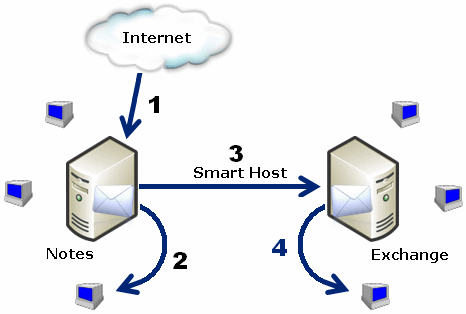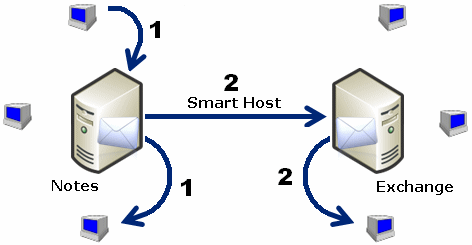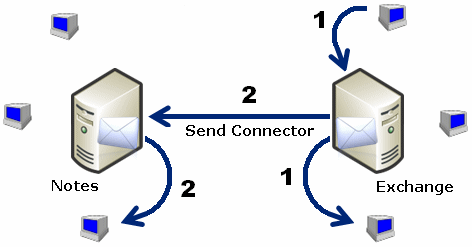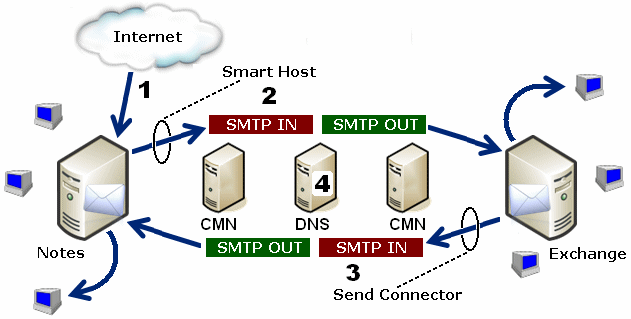Coexistence mail routing basics
Email coexistence, with or without CMN, can be configured within a single domain ("single namespace"), or you can differentiate the two environments with different domains or subdomains—for example, domino.sitraka.com vs. exchg.sitraka.com. CMN’s Mail Connector integrates easily into either method.
|
NOTE: When coexisting with Office 365: Direct free-busy lookups from Office 365 to Notes are not possible with a single-namespace configuration, in either a hybrid or non-hybrid implementation, due to access/permission restrictions to the remote Microsoft servers. Bi-directional free/busy features with Office 365 can be configured only with routing domains (e.g., coexist.sitraka.com). |
The multi-domain/subdomain methods are straightforward, but configuration is somewhat more complicated than with the single-namespace methods. A subdomain routing method may also introduce a risk that the assigned subdomain names will escape your organization’s internal communications, which in turn can cause bounce-backs on replies to those addresses. To prevent this, set the Notes forwarding address attribute to user@subdomain@notesdomain, which tells Domino to set the reply address for external email to the user's primary SMTP address (internet address field value).
A single-namespace mail coexistence is accomplished by using smart hosts in both directions.
Single-namespace message routing without CMN
Email coexistence, with or without CMN, can be configured within a single domain ("single namespace"), or you can differentiate the two environments with different domains or subdomains—for example, domino.sitraka.com vs. exchg.sitraka.com. CMN’s Mail Connector integrates easily into either method.
|
NOTE: When coexisting with Office 365: Direct free-busy lookups from Office 365 to Notes are not possible with a single-namespace configuration, in either a hybrid or non-hybrid implementation, due to access/permission restrictions to the remote Microsoft servers. Bi-directional free/busy features with Office 365 can be configured only with routing domains (e.g., coexist.sitraka.com). |
The multi-domain/subdomain methods are straightforward, but configuration is somewhat more complicated than with the single-namespace methods. A subdomain routing method may also introduce a risk that the assigned subdomain names will escape your organization’s internal communications, which in turn can cause bounce-backs on replies to those addresses. To prevent this, set the Notes forwarding address attribute to user@subdomain@notesdomain, which tells Domino to set the reply address for external email to the user's primary SMTP address (internet address field value).
A single-namespace mail coexistence is accomplished by using smart hosts in both directions.
Single-namespace message routing without CMN
The next three diagrams illustrate email routing in a single-namespace mail coexistence between Notes and Exchange—without CMN. This is native functionality and does not involve any Quest product.
The step numbers here correspond to the numbers in the diagram:
The step numbers here correspond to the numbers in the diagram:
|
1 |
Message sent from one native Notes user to another. Delivered locally: Domino recognizes the recipient’s valid local (Notes) address, so routes in internally rather than sending to the smart host. |
|
2 |
Message sent from native Notes user to Exchange user. Two possibilities: The Exchange user either is unknown to Notes, or is represented in Notes only by a person document. In either case, Notes cannot find a local mail file for the recipient, so routes the message to the smart host for relay to Exchange, where a recipient lookup permits delivery to the appropriate mailbox. If the recipient is present in the Domino directory, then Notes found the forwarding address in the contact document (mail system is also set to "Other Internet Mail") and sent it with the message to the smart host. |
The step numbers here correspond to the numbers in the diagram:
|
1 |
Message sent from one native Exchange user to another. Delivered locally: Exchange recognizes a valid local mailbox for the message, so routes it internally (doesn’t send it to the Send Connector for external delivery). |
|
2 |
Message sent from native Exchange user to Notes user. Two possibilities: The Notes user either is represented in Active Directory as an external contact, or is simply unknown to Exchange. In the first case, Exchange finds a forwarding address associated with the contact ("targetaddress" attribute in AD), and sends the message via the Send Connector to Domino, where it is delivered to the appropriate mail file. In the second case, the message is still routed to Notes via the Send Connector, but Notes will be able to deliver it only if the appropriate mail file exists. |
Email coexistence before and after CMN
Remember that email coexistence can be configured either within a single namespace, or by differentiating the two environments with different domains (or subdomains—e.g., domino.sitraka.com vs. exchg.sitraka.com). The CMN Mail Connector is easily integrated into either strategy, but most admins prefer the single-namespace approach because it is usually simpler to configure.
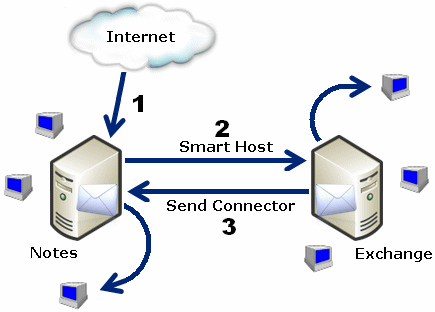
The step numbers here correspond to the numbers in the diagram:
|
NOTE: When coexisting with Office 365: Direct free-busy lookups from Office 365 to Notes are not possible with a single-namespace configuration, in either a hybrid or non-hybrid implementation, due to access/permission restrictions to the remote Microsoft servers. Bi-directional free/busy features with Office 365 can be configured only with routing domains (e.g., coexist.sitraka.com). |
The step numbers correspond to the numbers in the above diagram:
Any of CMN’s defined outbound servers may in turn point to a load balancer, in which case multiple DNS host records can be created, each for a different IP address, but the same host name. For example, three cmn.sitraka.com records can be created, each with a different IP. See this Microsoft article for more information about DNS round robin.

